HISTORIC ARCHIVE
Description from the 1895 Kelly's Directory
Litton Cheney is a parish near the Bredy river and the road from Bridport to Dorchester, 7 miles east-south-east from Bridport
station on the Great Western railway and 10 west from Dorchester, in the western division of the county. Uggescombe hundred,
Bridport Union and County Court district, Dorchester petty sessional division, rural deanery of Bridport (Abbotsbury portion),
archdeaconry of Dorset and diocese of Salisbury. The church of St Mary is an ancient stone building, in the Perpendicular style,
in good preservation, and consists of chancel, nave, transepts, south íporch and a lofty embattled western tower, containing 6
bells and a clock: the chancel arch is panelled like those of Sherborne: the nave is wide, and the roof, formerly barrell-shaped,
has been altered to an open pointed roof: the font is formed of the inverted base of a Norman circular pier; the pulpit has traceried
perpendicular panels: there is a monument to George Dawbeny, of Gorwell, who died in 1612: and brasses to Anna Henvill and
Margaret Henvill, d. 1681: and to Ralph Henvill of Looke, gent. d. 9 Dec 1644: there are 220 sittings. The register dates from the
year 1624. The living is a rectory, average tithe rent- charge £485, gross yearly value £650, net £560, with 109 acres of glebe
and residence, in the gift of and held since 1893 by the Rev. Frederick William Crick M.A. of Pembroke College, Cambridge.
Here is a Primitive Methodist chapel. There is no manor. The principal landowners are Henry Brinsley Sheridan esq. And Mrs
Legge, of Court House. The soil is chalk; subsoil, gravel. The chief crops are wheat, barley and some land in pasture. The area
is 3,817 acres; rateable value, £3,671; the population in 1891 was 427.
Nether Combe is a hamlet one mile west : Stancombe is a hamlet 1½ miles north; Higher Eggardon, a hamlet 4 miles
north, where there are the remains of an extensive Roman encampment, was by Local Government Board Order
transferred to Askerswell, March 24
th
1884: Ashley, 1½ miles, and Gorwell, 2 miles south-east, have been transferred to
Longbredy.
Sexton, George Fry.
Post Office.-Robert Bligdon, sub-postmaster. Letters from Dorchester arrive at 8.30 a.m.; dispatched at 6 p.m.; sundays,
arrive at 8.30 a.m.; dispatched 10.30 a.m. Postal orders are issued here, but not paid.
The nearest money order office is at Abbotsbury & telegraph office at Littlebredy.
Parochial school (mixed), endowed with £30 yearly from Thorner’s charity, with residence for master, built in 1878, for 80
children; average attendance, 63; Wm. Stephen Miller, master.
Carriers.
George Gale, Dorchester, Wed. & Sat.
Charles Webber, Bridport, Wed. & Sat.
Bligdon& Pitcher, Dorchester, Sat.
1865
1880
1895
1935
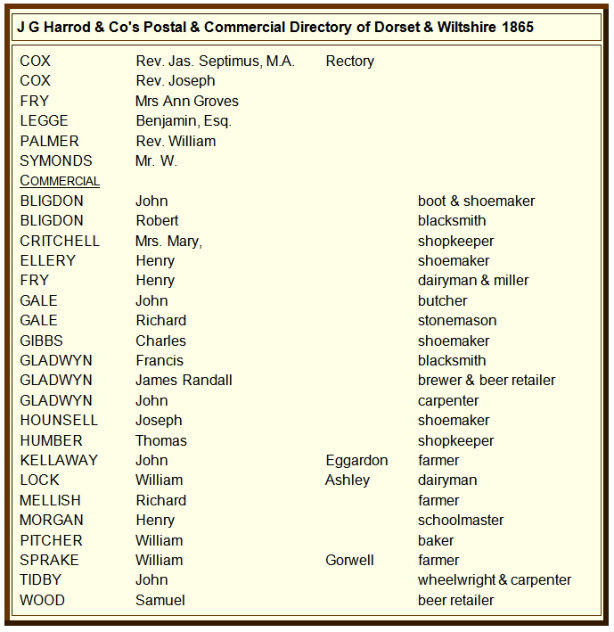
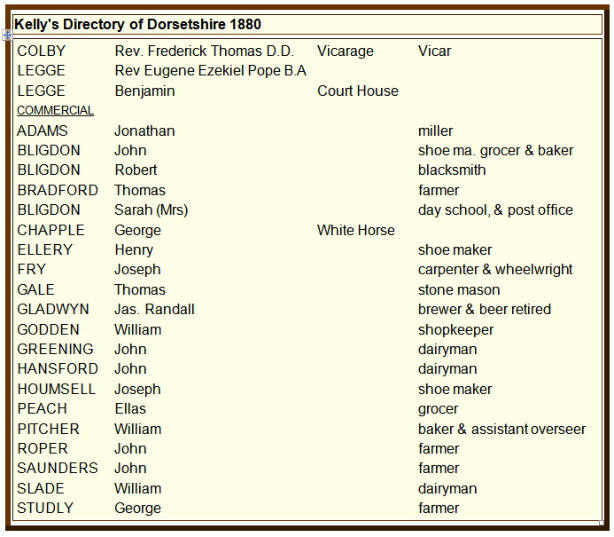
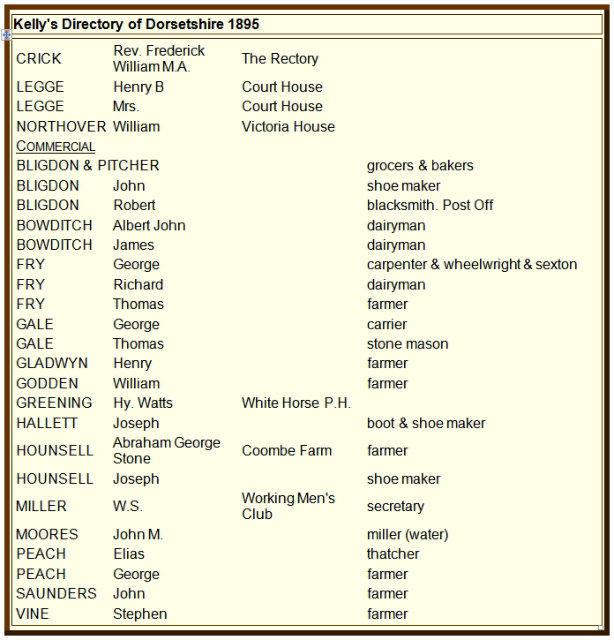
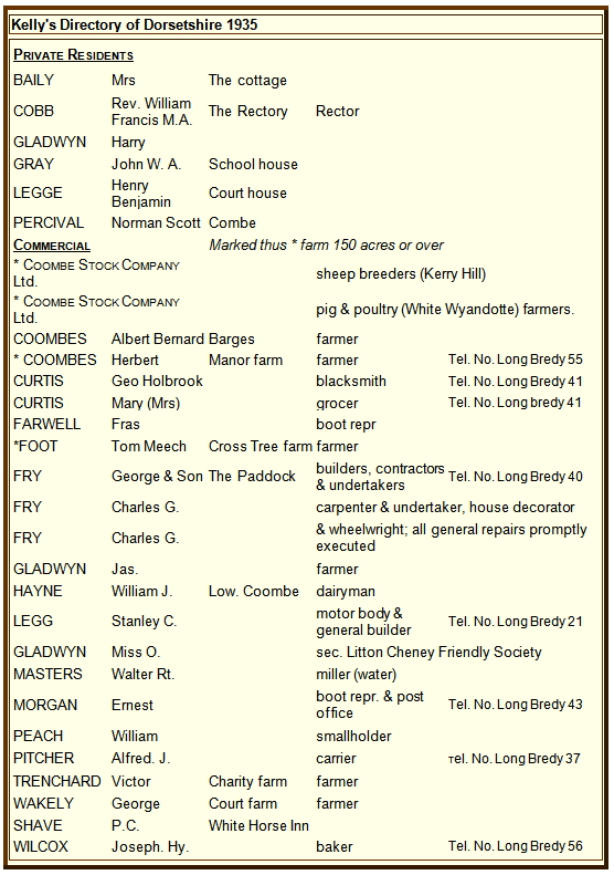
JOHN HAWKINS
The Life of John Hawkins (1780-1833)
The bells were ringing as a small group of people walked up the hill to the parish church of St. Mary's in Litton Cheney. It was the 4th
January 1781 and John HAWKINS a 34 year old yeoman farmer from nearby Looke Farm, his wife Agnes and their two year old son,
James had walked to Litton for the baptism of their new baby. Accompanying them was Agnes's father, James Hawkins, who had
lived an active life as a blacksmith and victualler and was the inn-keeper at the New Inn in Litton where he had lived all his life. This
was the first baptism in the village for two months so probably many locals joined in to see the little baby being named John.
In 1793, aged just 13 years of age, the young John said goodbye to his family
and friends and travelled to Portsmouth where on the 24th March his name
was entered in the books of His Majesty's Ship Culloden as a captain's
servant. During his time on board the Culloden he witnessed a mutiny in
1793 following which six sailors were hung from the yardarm, took part in the
'Glorious First of July', the Battle of Cape St Vincent, Santa Cruz where
Nelson lost his arm, and the Battle of the Nile in 1798 - all before his 20th
birthday. In 1800 he passed his lieutenant's certifiate and whilst serving on
board the 16 gun brig, Atalante, he was involved in a cutting out expedition at
Quiberon Bay which earned him a Lloyds Patriotic Sword to the value of
£50.00.
In February 1807 the Atalante ran aground on the Ile de Re and Hawkins and about half
the crew were rescued. After that horrifying experience he served on several ships until
he was taken ill whilst serving on board the Electra at Newfoundland in 1812. He made
his way home and recovered but by then there were many redundant officers and he
was put on half-pay and never served again. When seeking a new ship after 1812 he
wrote to the Admiralty saying he was a 'poor naval officer' and he had a 'growing family';
there appears to be no evidence of this being so.
Upon his return to Dorset he found that his parents were running the inn at Litton
Cheney together with a brother William and sister Elizabeth.
In 1820 a certain James Hawkins was
committed and brought to court on he 20th
September for smuggling. He was described
as being 5' 5" tall with brown hair, grey eyes, and a fair complexion with a cut over the left
eyebrow. He was a married man from Melcombe Regis aged 39 and he was imprisoned in
Dorchester Gaol until £100 be sooner paid. There is no knowing if this is John Hawkins'
brother as the date of birth does not correspond, but Hawkins would have had infinite
knowledge of seamanship, free-trading was rife in this area and he was certainly bitter
towards the authorities.
John Hawkins died in 1833 and The Dorset County Chronicle and Somersetshire Gazette
recorded his obituary - "July 24 1833, at Piddletrenthide, sincerely lamented by his disconsolate widow and numerous friends, John
Hawkins Esq. Captain of the Royal Navy, aged 52. He was universally esteemed by his brother officers and the men under
hiscommand; and was an active and brave officer. In 1803, being First Lieutenant of the Atalante, he cut out and otherwise
destroyed three vessels full of troops at anchor, under the enemy's batteries in Quiberon Bay. For this meritorious achievement, his
only reward was a sword from the Patriotic Fund, accompanied by a vote of thanks, as a testimony of their approbation of his gallant
conduct, as copied in the London Gazette. In 1830 this brave defender of his country was placed upon the list of Retired
Commanders."
In 1834 his mother, Agnes died at Litton Cheney and his brother, James, died at Tindeton. James's wife and eight children, the
youngest of whom was only four, left their home presumably because the breadwinner had died, and trudged to Fordington near
Dorchester where they lived in the notorious Mill Street. In later years cholera struck the family and Sarah, James' wife, eventually
died as an 82 year old pauper in 1862.
On the 25th March 1838, John's wife Elizabeth Hawkins died from apoplexy. Her will reveals that she died a rich woman without any
living children. For the wife of a 'poor' naval officer with a 'growing family' this seems very strange and perhaps gives credence to the
smuggling theory especially as the village of Piddletrenthide, where John and Elizabeth lived from at least 1830, was well known as
a storage centre for contraband. In her will she instructed her cousin, John MILLMAN of the Naval Hospital in Plymouth, to arrange
to ship to her sister Sally DUCHEMIN, te wife of Watson Duchemin, pump and blockmaker of Charlottetown in Prince Edward Island,
a chest containing many of her effects: a gold watch, jewelery, silverware, her wedding ring, holy bible and clothing etc.
Both John and Elizabeth were buried at Piddletrenthide but only the bottom half of the stone can be found and that has been used as
a path! The graves of a number of the Hawkins family can be found at Litton Cheney.
I inherited the Hawkins watch from my grandmother, Cissie TOWILLS who in turn had been given it by her father, James Hawkins
Towills whose mother was Ann Pearce Hawkins, the daughter of John Hawkins's brother. The Lloyds Patriotic Sword is in the Nelson
Collection at Lloyds in London.
In the 1980s Lillian Duchemin, a descendant of Watson and Sally Duchemin made contact and she had, in her possession, the original
packing slip that accompanied the chest shipped out to Prince Edward Island by John Millman. Watson Duchemin was a very clever
man and took out the first ever patent for the roller bearing and in his spare time he built pipe organs, one of which has been
renovated and is in use at the University of Charlottetown
John Callcut
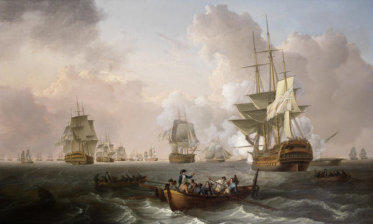
HMS Culloden - aground at the Battle of the Nile
HMS Atalante at Quiberon Bay - October 1803
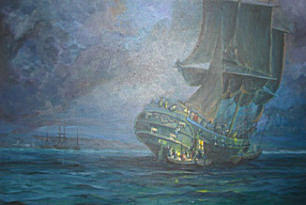
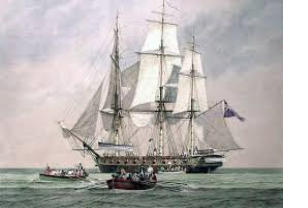
HMS Atalante in calmer times
TRANSCRIPT OF HUNT & Co’S DIRECTORY 1851
LITTON CHENEY, a village, said to have been once a market town, about 6 miles E.N.E. from Bridport. The Church is dedicated
to St. Mary, and the living is a rectory value £800. The parish comprises 2330 acres, and the population in 1841 was 463.
Cousins John, esq.
Cox Rev. James S. A.M. (rector)
Cox Rev. Joseph, M.A.
Fry George, esq.
Omber Miss Mary
Bligdon William, blacksmith
Bligdon John, boot & shoemaker
Brown Samuel, farmer, Loder lawn
Cox Joseph, farmer
Critchell Henry, grocery &c. dealer
Davis Henry, yeoman, Coombe
Fry Joseph, carpenter
Fry Stephen, dairyman
Gale John, butcher
Gale Richard G. mason
Gibbs Charles, boot & shoe maker
Gladwyn Francis, blacksmith
Gladwyn Francis, brewer & maltster
Gladwyn John, carpenter and wheelwright
Hawkins Wm. beer retailer & baker
Kellaway John, farmer
Legg Wm. farmer & maltster
Mellish Richard, farmer
Pitcher William, baker
Pitfield John, miller & assistant overseer
Scadden Joseph, farmer
Shire Bernard, farmer
Thorner's School, (Endowed for educating & apprenticing boys), Morgan Henry, master
Tidby John, wheelwright
Vine James, dairyman



Transcription from ‘A Topographical Dictionary of England’, 7th Edition, 1858
LITTON-CHENEY (St. Mary), a parish, in the union of Bridport, hundred of Uggscombe, Dorchester division of Dorset, 6¾ miles (E. S. E.) from
the town of Bridport; containing 463 inhabitants. The living is a rectory, valued in the king's books at £33. 7. 8½., and in the gift of the Rev. James
Cox, D.D.: the tithes have been commuted for £650, and there is a glebe of 117 acres. The church is in the later English style, and has a fine
tower with battlements and pinnacles. In 1690, Robert Thornhill (sic) bequeathed £25 per annum for the maintenance of a free school here, and
£75 per annum for apprenticing children of various places. In 1771, Thomas Hollis gave two acres of land, and a house for the schoolmaster's
residence.
Village Information v
Local Amenities v
Village Amenities v
About Litton Cheney v
Dorset Council v
Parish Council v